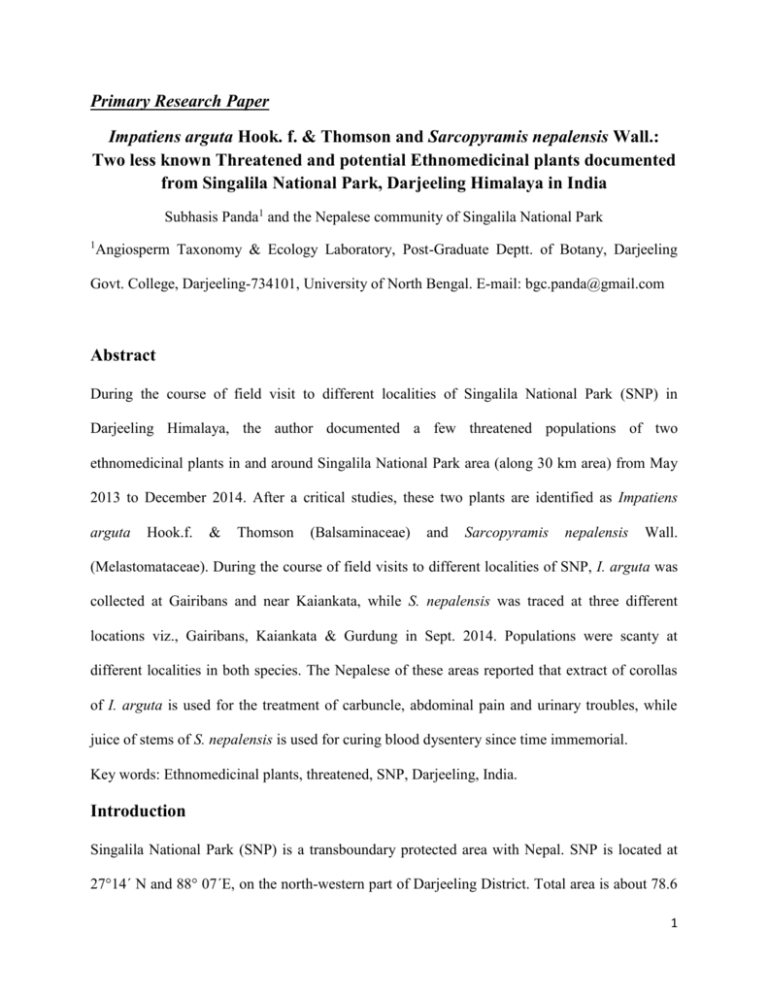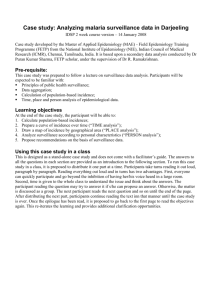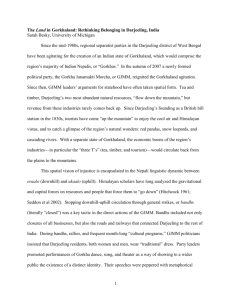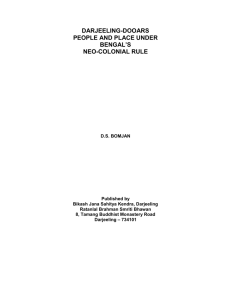Two less known Threatened and potential Ethnomedicinal plants
advertisement

Primary Research Paper Impatiens arguta Hook. f. & Thomson and Sarcopyramis nepalensis Wall.: Two less known Threatened and potential Ethnomedicinal plants documented from Singalila National Park, Darjeeling Himalaya in India Subhasis Panda1 and the Nepalese community of Singalila National Park 1 Angiosperm Taxonomy & Ecology Laboratory, Post-Graduate Deptt. of Botany, Darjeeling Govt. College, Darjeeling-734101, University of North Bengal. E-mail: bgc.panda@gmail.com Abstract During the course of field visit to different localities of Singalila National Park (SNP) in Darjeeling Himalaya, the author documented a few threatened populations of two ethnomedicinal plants in and around Singalila National Park area (along 30 km area) from May 2013 to December 2014. After a critical studies, these two plants are identified as Impatiens arguta Hook.f. & Thomson (Balsaminaceae) and Sarcopyramis nepalensis Wall. (Melastomataceae). During the course of field visits to different localities of SNP, I. arguta was collected at Gairibans and near Kaiankata, while S. nepalensis was traced at three different locations viz., Gairibans, Kaiankata & Gurdung in Sept. 2014. Populations were scanty at different localities in both species. The Nepalese of these areas reported that extract of corollas of I. arguta is used for the treatment of carbuncle, abdominal pain and urinary troubles, while juice of stems of S. nepalensis is used for curing blood dysentery since time immemorial. Key words: Ethnomedicinal plants, threatened, SNP, Darjeeling, India. Introduction Singalila National Park (SNP) is a transboundary protected area with Nepal. SNP is located at 27°14´ N and 88° 07´E, on the north-western part of Darjeeling District. Total area is about 78.6 1 sq. km. It is bordered on the north by the state of Sikkim, west by the country of Nepal while south & east by the state of West Bengal (Map 1). The Core Area of Singalila National Park is located on the Singalila Ridge at altitudes ranging from 8000 – 12000 ft in Darjeeling district of West Bengal, although the average altitude of the Buffer area is about 6000 ft. The Park was declared as wildlife Sanctuary in 1986, and was made as the National Park in 1992. Two highest peaks Sandakphu (3630 m) and Phalut (3600 m) are located on the ridge and inside the Park. Rivers Rammam and Srikhola flow down through the Park. SNP starts just after Tumling and continues up to Phalut through Gairibans, Kaiankata, Kalapokhri, BK Bhanjang, Sandakphu, and Sabargram (Sabarkum) trek route on one way, while from Phalut to Srikhola village through Gorkhey, Molle, Rammam on another second trek route. Besides, another third way is also existing directly from Sandakphu via Gurdung up to Srikhola. Place of Map 1 2 During the course of field visits under University Grants Commission’s Research Project, the author collected and documented a few threatened populations of two ethnomedicinal plants in and around Singaliala National Park area (along 50 km area) from May 2013 to December 2014 in different seasons viz., May 2013, November 2013, March 2014, May 2014, September 2014 and December 2014. After a critical studies, these two plants are identified as Impatiens arguta Hook. f. & Thomson (Balsaminaceae) and Sarcopyramis nepalensis Wall. (Melastomataceae). During the course of field visits to different localities of SNP, Impatiens arguta was collected at Gairibans and near Kaiankata, while S. nepalensis was traced at three different locations viz., Gairibans, Kaiankata & Sandakphu-Gurdung hillside slopes in Sept. 2014. Populations were 3 scanty at different localities in both species. No detailed studies were made in respect to these two species either taxonomically or ethnobotanically, except the present work. Probably J. D. Hooker was first to explore the present area of this Park extensively in AprilAugust, 1848 during his voyage to the Himalayas and he published 7-volumed books “Flora of British India” (1875 – 1897) which are considered as the first documentation. Since Hooker, several other workers like C. B. Clarke (published in J.D. Hooker’s Flora of British India), Gamble (1896), Biswas & Chopra (1956), Hara (1966), Biswas (1966), Mukherjee (1988), Das (1995, 2004), Saini (2000), Gurung & Palit (2007), Lama (2004), Rai (2006), Debta & Chowdhury (2006: unpublished), Panda (2012), Panda & Reveal (2012) surveyed the area and documented floristic elements in various ways, but very little or no investigations regarding Indigenous Traditional Knowledge (ITK) and conservation on Threatened taxa including these two species were made. Therefore, a detailed investigation on these two species regarding field description for easy identification purpose, documentation of Threatened categories, their Traditional Knowledge and finally their conservation aspects is discussed. Material and methods The present work is the result of a critical study of literature in libraries and specimens in herbaria as well as in the field. The work was carried out in the laboratory of Angiosperm Taxonomy & Ecology, Post-Graduate Department of Botany, Darjeeling Govt. College and partly at Central National Herbarium, Botanical Survey of India, Howrah. In the first phase, published and documented ethnomedicinal plants of Singalila National Park were listed based on consulted literature and herbarium data. To collect the literature following libraries were consulted: Central National Herbarium (CAL), Botanical Survey of India, Howrah, Botanical 4 Survey Sikkim Himalayan Circle (BSHC), Gangtok and Lloyd Botanical Garden, Darjeeling. Herbaria such as Central National Herbarium (CAL), Industrial Section Indian Museum (BSIS), Kolkata, and Lloyd Botanical Garden Herbarium, Darjeeling were visited for herbarium consultations. For detailed study, floral parts of these two live plants were dissected and examined. The terminology for different external morphological characters were followed mainly Lawrence (1951), Featherly (1954), Stearn (1983), Radford (1986) and Veldkamp in Vogel (1987). All measurements were given in metric system. In case of herbarium specimens, after the evaluation of the annotations of earlier workers on the herbarium specimens and comparing them with the type specimens and protologues and with collected live materials, a detailed field description of these two species were made. Besides the study of specimens in different herbaria, studies were conducted to observe the plants in their natural habitats, to record the colour of flowers, fragrance and indumentum, the range of variations, their abundancy and rarity, presence of nectaries, altitude, habitat and to assess the conservation status. For ethnomedicinal investigation, the first hand Indigenous Traditional Knowledge (ITK) or information were recorded during field visits at different localities in Singalila National Park (Tumling, Gairibans, Kaiankata, Kalapokhri, Sandakphu, Sabargram, Phalut, Gorkhey, Molle, Rammam, Gurdung and Srikhola villages) through an oral interviews of experienced and elderly tribal people, local medicinemen and field guides. Detailed information regarding local names(s), 5 part(s) used, mode of administration or preparation and dosimetry are recorded in the field note book. Botanical identity is confirmed with herbarium consultations in Central National Herbarium (CAL). Important voucher specimens are deposited in the laboratory of Angiosperm Taxonomy & Ecology, Botany Deptt., Darjeeling Govt. College, Darjeeling. Authors of scientific names are abbreviated according to Brummitt and Powell (1992), Authors of Plant Names. Books title are abbreviated according to Stafleu and Cowan (1976 – 1988), Taxonomic Literature (ed.2, vols. 1 – 7), Stafleu and Mennega (1992 – 2000), Taxonomic Literature, suppl. vols. 1 – 6. Herbarium acronyms are followed according to Holmgren et al. (1990), Index Herbariorum, part 1 (ed.8). Results 1. Family: Balsaminaceae Impatiens arguta Hook. f. & Thomson, J. Proc. Linn. Soc. Bot. London 4: 137. 1860; Hook. f. in Hook. f., Fl. Brit. India 1: 470. 1875; Biswas, Pl. Darj. Sikim Himal. 1: 207. 1966; H. Hara, Fl. E Himal. 1: 194. 1966; 2: 74. 1971 & 3: 78. 1975; H. Hara in H. Hara & Williams, Enum. Fl. Pl. Nepal 2: 78. 1979; Grey-Wilson in Grierson & Long (eds.), Fl. Bhutan 2(1): 92. 1991; Akiyama et al., Bull. Natn. Sci. Mus. Ser. B. 21 (4): 151-168. 1995; Vivekananthan et al. in Hazra et al. (eds.), Fl. India 4: 120. 1997; Yilin et al., Fl. China 12: 81. 2007. Type: India, Sikkim, 5000-7000 ft, JDH 101, Kew Barcode no. K000694618 (K!). I. gagei Hook. f. in Hook., Icon. Pl. ser. 4: t. 2951. 1913. (Fig. 1) Vernacular name: Turie (Nepalese of Gairibans & Kaiankata, Darjeeling). Description based on field data: Perennial herb up to 60 cm high; lamina lanceolate, ellipticlanceolate to very rarely ovate-lanceolate, leaf apex caudate-acuminate, acuminate to very rarely 6 7 acute, leaf margin argute-serrate (finely serrate); inflorescence 1-2-flowered; flowers pinkishviolet to purple-red; outer 2 lateral sepals ovate with cuspidate-acuminate apex; lower sepal saccate and narrowed into an incurved, short spur, spur yellowish; upper petal orbicular, purplered, lateral united petals not clawed, 2-lobed; capsule narrow, stout, linear, green; seeds glabrous, grey-white (submature). Distribution: India— (E Himalayas—Sikkim, Darjeeling in West Bengal, Arunachal Pradesh; Nagaland, Manipur, Meghalaya); Nepal, Bhutan, SW China, N Myanmar at altitudes ranging from 1800 to 2900 m. Habitat: Growing in moist and shady places of rocky slopes. Status: Threatened---two populations surveyed, viz., i. Gairibans population consisting of 10 individual plants in approx. 10 m2 area.,GPS location: 27°.0´44´´N and 88°.10´33´´E, altitude— ca. 8600 ft, and ii. Kaiankata population consisting of 7 individual plants in approx. 20 m2 area, GPS location: 27°.0´48´´N and 88°.10´47´´E, altitude—ca. 9200 ft. Flowering: Late July –early October. Fruiting: August-November. Ethnomedicinal ITK: Fresh and washed corollas (7-10 per day for 2 days) are mixed with 30 ml of water and taken to relieve from abdominal pain, urinary or kidney problems (10-12 flowers per day for 10 days) and carbuncles (4-5 corollas are made into paste and applied)---This oral interviews were conducted with the Nepalese knowledgeable persons at Gairibans & Kaiankata villages on 20th & 21st September, 2014 during field visit to Sandakphu. They are habituated with these traditional herbal drugs since time immemorial, as they are living far from cities & towns, they have no other means to cure diseases except traditional natural herbal drug plants, because they prefer to live in forest-dominated area. 8 Specimen examined: Singalial National Park, Darjeeling, Gairibans, 27°.0´44´´N and 88°.10´33´´E, 8600 ft, 20/09/2014, S. Panda 167 (Darjeeling Govt. College Herbarium). 2. Family: Melastomataceae Sarcopyramis nepalensis Wall., Tent. Fl. Nepal. 1: 32, t. 23. 1824; C. B. Clarke in Hook. f., Fl. Brit. India 2: 541. 1879; Chen Jie & S.S. Renner, Fl. China 13: 388. 2007. Type: Nepal, Wallich 4088, Kew Barcode no. K000867700 (K!). Synonyms: Sarcopyramis lanceolata Wall. ex Benn., Pl. Jav. Rar.: 214. 1844. Phyllagathis chinensis Dunn, J. Linn. Soc. Bot. 38 (267): 360. 1908. Sarcopyramis dielsii Hu, Bull. Fan Mem. Inst. Biol. Bot. 7: 216. 1936. S. nepalensis Wall. var. maculata C. Y. Wu & C. Chen, Fl. Yunnan. 2: 121. 1979. (Fig. 2) Vernacular name: Charibang (Nepalese of Gairibans & Gurdung, Darjeeling). Description based on field data: Perennial herb up to 35 cm high; stem 4-sided, winged, succulent, glabrous; lamina ovate to ovate-lanceolate, leaf apex acuminate, leaf margin serrate; adaxial suface beset with a few strigose white hairs; inflorescence 1-3-flowered; flowering bract subsessile, foliaceous green; pedicels 4-sided, slightly winged; hypanthium 4-sided, narrowly winged, brownish-green with 4 lobes; corolla 4-lobed, pinkish-purple; capsule cup-shaped, 4sided, brownish-red. Distribution: India— (E Himalayas—Sikkim, Darjeeling in West Bengal, Arunachal Pradesh; Nagaland, Manipur, Meghalaya); Nepal, Bhutan, SW China; N Myanmar, Thailand, Malaysia, Indonesia, Philippines at altitudes ranging from 2000 to 3000 m. Habitat: Growing in moist and shady places of rocky slopes, mostly along wet nullah, on the bank of spring. Status: Extremely Threatened---three populations surveyed, viz., i. Gairibans population consisting of 4 individual plants in approx. 20 m2 area, GPS location: 27°.0´44´´N and 9 10 88°.10´33´´E, altitude—ca. 8600 ft, ii. Kaiankata population consisting of 6 individual plants in approx. 10 m2 area, GPS location: 27°.0´48´´N and 88°.10´47´´E, altitude—ca. 9200 ft. and iii. Gurdung population consisting of 3 individual plants in approx. 20 m 2 area, GPS location: 27°.27´4´´N and 88°.29´41´´E, altitude—ca. 8000 ft. Flowering: Late July –early October. Fruiting: Late August-November. Ethnomedicinal ITK: Juice of fresh and washed stems and petioles (50 ml per day for 5 days) are taken to cure blood dysentery---This oral interviews were conducted with the Nepalese knowledgeable persons at Gairibans, Kaiankata and Gurdung villages on 20th, 21st and 22nd September, 2014 during field visit to Sandakphu. Specimen examined: Singalial National Park, Darjeeling, Gairibans, 8600 ft, 20/09/2014, S. Panda 169; Gurdung, 27°.27´4´´N and 88°.29´41´´E, 8000 ft, 22/09/2014, S. Panda 192 (Darjeeling Govt. College Herbarium). Acknowledgements The author thanks University Grants Commission, New Delhi for sanctioning minor research project for studying threatened ethnomedicinal plants in Singalial National Park, Darjeeling Himalaya. The Author is also grateful to Dr. P. Lama, Officer-In-Charge and Dr. A. Bhattacharya, Head Deptt. of Botany for providing necessary facilities during this work. Finally, the author is thankful to the local Nepalese communities of SNP area for their cooperation and disclosing first hand indigenous traditional knowledge during oral interviews. References Biswas, K.P. (1966). Plants of Darjeeling and Sikkim Himalayas, Calcutta. Biswas, K. and Chopra, R.N. (1956). Common Medicinal Plants of Darjeeling and Sikkim 11 Himalaya, Bengal Govt. Press, Calcutta. Brummitt, R.K. and Powell, C.E. (1992). Authors of Plant Names. Royal Botanic Gardens, Kew, United Kingdom. Das, A.P. (1995). Diversity of angiospermic flora of Darjeeling hills. In: Pandey, A.K. (ed.) Taxonomy and Biodiversity, CBS Publishers and Distributors, New Delhi. Das, A.P. (2004). Floristic Studies in Darjeeling Hills. Bull. Bot. Surv. India 43 (1-4): 1-18. Featherly, H.I. (1954). Taxonomic Terminology of the Higher Plants: pp. 1 – 166, Ames, Iowa USA. Gamble, J.S. (1896). List of the Trees, Shrubs and large climbers found in the Darjeeling District, Bengal, Presidency Jail Press, Calcutta. Gurung, S. and Palit, D. (2007). Medicinal plant lore among Lepchas in Darjeeling District, West Bengal, India. Proc. National Symposium on Medicinal and Aromatic Plants for Economic Benefit of Rural People (MAPER), pp. 37-41, Ramakrishna Vivekananda Mission of Advanced Studies, Kolkata. Hara, H. (1966). The Flora of Eastern Himalaya – Results of the Botanical Expedition to Eastern Himalaya organized by the University of Tokyo, 1960 – 1963. 1st Report, University of Tokyo Press, Japan. Holmgren, P.K., Holmgren, N.H. an Barnett, L. C. (1990). Index Herbariorum, part 1: The Herbaria of the World, ed. 8, New York Botanical Garden, Bronx, NewYork, U.S.A. Hooker, J.D. (1875 – 1897). The Flora of British India. vols. 1 – 7, Reeve & Co., London. Lama, D. (2004). Taxonomical, distributional and ecological studies of Acer L. (Aceraceae) in the Darjeeling-Sikkim Himalayas, Ph.D. thesis, North Bengal University. Lawrence, G.H.M. (1951). Taxonomy of Vascular Plants, Macmillan Co., New York, USA. Mukherjee, A. (1988). Flowering Plants of Darjeeling, Pp. 1-287, Atma Ram & Sons, Delhi. Panda, S. (2012). Gaultheria stapfiana Airy Shaw (Ericaceae), a species to be recognized: insights from morphology, leaf anatomy and pollen morphology. Phytotaxa 58: 1-12. 12 Panda, S. and Reveal J.L. (2012). A Step-Two Lectotypification and Epitypification of Pentapterygium sikkimenseW.W.Sm. (Ericaceae) with an amplified description. Phytoneuron 2012-8: 1-7. Radford, A.E. (1986). Ericaceae. Fundamentals of Plant Systematics: pp. 365 – 367, Harpers & Row, New York, USA. Rai, U. (2006). Characterization of Plant Biodiversity in Darjeeling Hills using Remote Sensing Techniques. Ph.D. Thesis, North Bengal University. Saini, R.P. (2000). Medicinal Plants of Darjeeling Hills-A study by Silviculture (Hills) Division. Indian Forester 128: 822 – 837. Stafleu, F.A. and Cowan, R.S. (1976 – 1988), Taxonomic Literature, ed. 2 (vols. 1 – 7), Bohn, Scheltema & Holkema, Utrecht. Stafleu, F.A. and Mennega, E.A. (1992 – 2000). Taxonomic Literature, suppl. vols. 1 – 6, Koeltz Scientific Books, Konigstein, Germany. Stearn, W.T. (1983). Botanical Latin, 3rd revised ed., David & Charles Inc., USA. Veldkamp, J.F. (1987). Manual for the description of Flowering Plants. In: Vogel, E. F., Manual of Herbarium Taxonomy: Theory and Practice: 20 – 64, UNESCO Regional Office, Jakarta (Indonesia). 13









